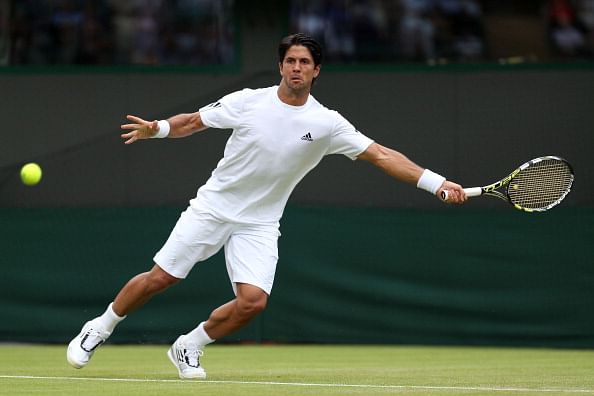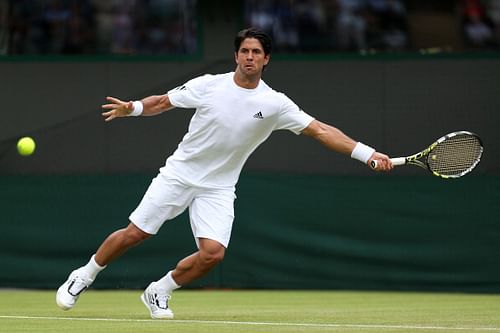
Wimbledon: It's second serve in Fernando Verdasco's career

Fernando Verdasco of Spain plays a forehand during his Gentlemen’s Singles second round match against Julien Benneteau of France
The bullet forehands were back. The backhand slice worked to perfection. The serve was consistent, reliable and somewhere close to returning to its best. The result – a straight sets win against a seeded opponent – was a sweet one to savour. But more than anything else, the aggression was back, the self-belief shone through brighter as the match progressed and those painful mental demons en route to being vanquished. This could potentially be the second coming of Fernando Verdasco.
Rewind to 2009 and Verdasco was rivalling David Ferrer as Spain’s second best singles player behind Rafael Nadal. The Madridista was in fact placed higher than the current world number 4, reaching a career-best ranking of 7 in April that year. The left-hander had earned that spot on the back of some fabulous, consistent tennis which included a narrow semi-final loss to Nadal in the Australian Open and quarter final showings at each of the first five Masters 1000 events of the year. He stayed in and around the top 10 for the most part till March 2011, following which his levels dropped drastically landing him at 54 heading into this year’s Wimbledon.
But in interviews and press conferences ahead of the Championships, the Verdasco camp appeared quietly confident of a good tournament. The results from earlier on in the year had nothing great to write home about. A 7-12 match record with no wins against a Top-20 ranked player should indeed have been cause for great concern.
But the last two tournaments he played definitely showed an upswing in performance from the 29-year-old Spaniard. Although he fell in the second round at the French Open on his beloved red clay, he did push eighth-seeded Serbian Janko Tipsarevic all the way before succumbing 6-8 in the fifth. And he opened up his grass court swing with a quarterfinal appearance at Eastbourne, which included a win over world No.24 Alexandr Dolgopolov of Ukraine.
The 7-6, 7-6, 6-4 win over No.31 seed Julien Benneteau in the Wimbledon second round on Wednesday is arguably even more commendable considering the French veteran is enjoying the best singles form of his life. He reached a career high 26 last April and was two sets up against eventual winner Roger Federer in the third round at SW19 last year before the Swiss master’s imperious comeback. But he went on to beat Fedex in Rotterdam earlier this year and reached the final of that tournament before losing to Juan Martin del Potro.
While he lost a set to Tobias Kamke of Germany in the first round, the 31-year-old still showed that his booming serve and solid two-handed backhand were working well while his doubles background has meant he always has been effective coming to the net either on the back of his serve or midway through rallies. Benneteau is also a very good returner of serve and the fact that he could manage just one break in the entire match against Verdasco is testament to how well the Spaniard served throughout the encounter. The Frenchman’s backhand misfired more than usual in this game but even if that had been addressed, it is difficult to see how he could have overcome Verdasco.
The Spaniard started like a man on a mission and ended it in very much the same vein. In years past, facing a set point in the tie-break after playing as well as he did in the first set might have been enough for Verdasco to fall apart but this time around, he kept his nerve and never looked in too much difficulty from there on. Never a man to play too much of percentage tennis, Verdasco went for his shots particularly on the forehand side and made them more often than not. As he showed during his peak years, when he is on song, even the best can struggle to deal with the depth, variation and power of his forehand.
What he lacked in power in his serve, he made up with placement and craft. The swinging serve down-the-middle from the deuce court consistently set up easy winners on either side with Benneteau dragged into the middle of the court. He used the backhand slice effectively to frustrate his opponent and as he did to clinch the tie on his second match point, did very well to execute some tough passing shots from either side. At 6’2” he is about the height regarded as ideal to be a top tennis player and he used his frame well, keeping a low centre of gravity to execute some difficult, whipped passes. And as his confidence grew with each set, the classic fearlessness that once made him such a daunting opponent also returned. A 113-mile-an-hour-second-serve down the T at 0-15 while serving for the match was a clear example of this.
Verdasco next faces the Latvian Ernest Gulbis who benefited from the injury-forced pulling out of Jo Wilfried Tsonga. If he comes through that clash and given the withdrawal of Marin Cilic as well, his fourth round opponent could be 22nd seed Juan Monaco. On grass, Verdasco on current form should be able to overcome the Argentine and set up a potential quarter final against Andy Murray. Is the Spaniard’s improvement in form good enough to better the home favourite? It will certainly be difficult and perhaps improbable but if he plays the way he did against Benneteau, do not rule out an upset.